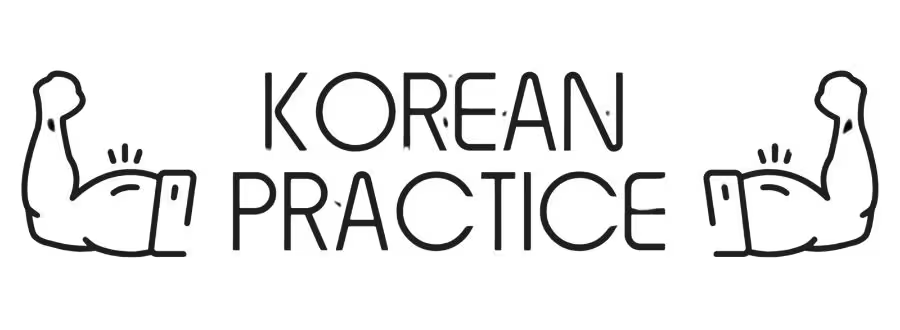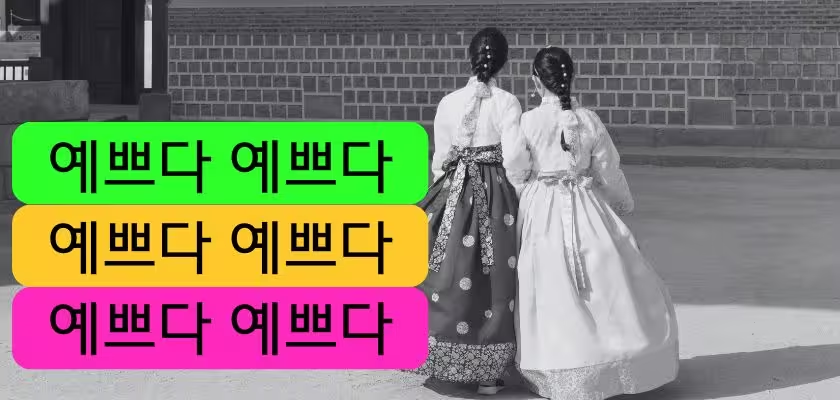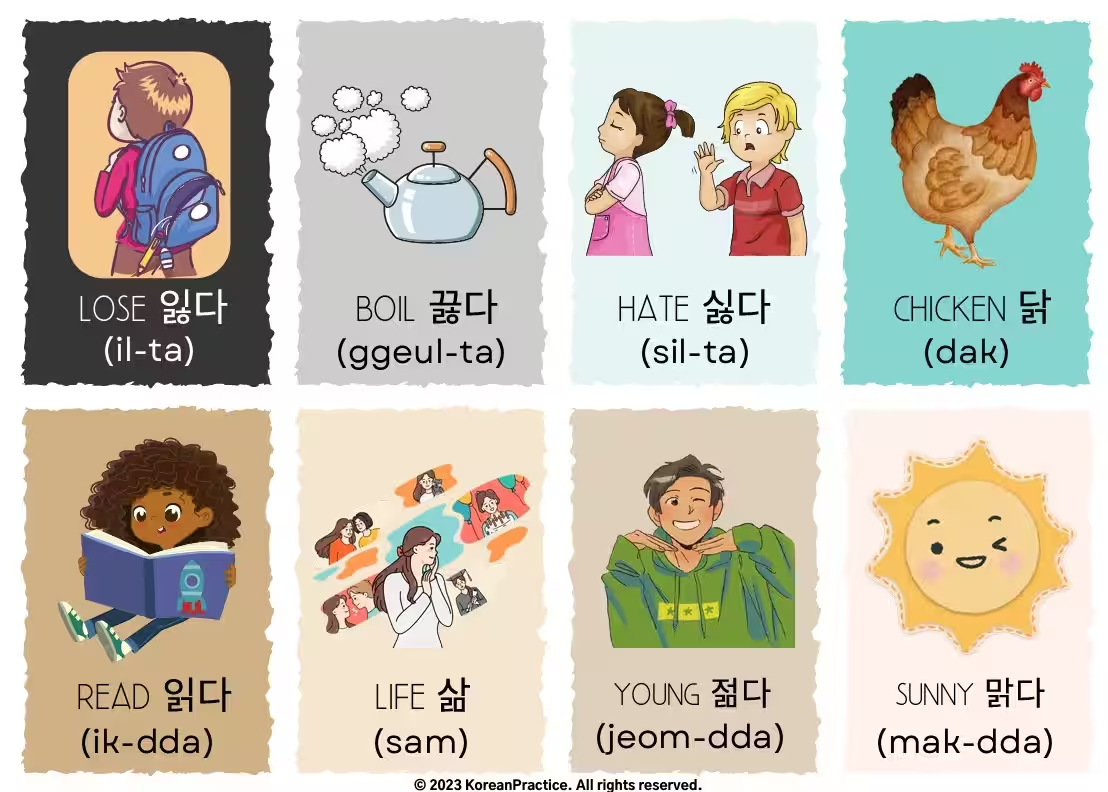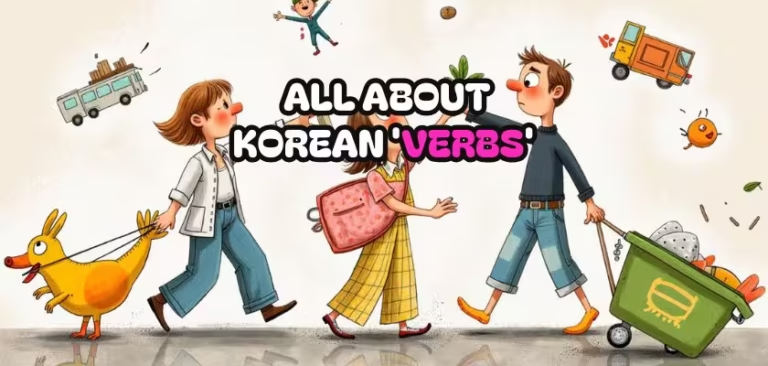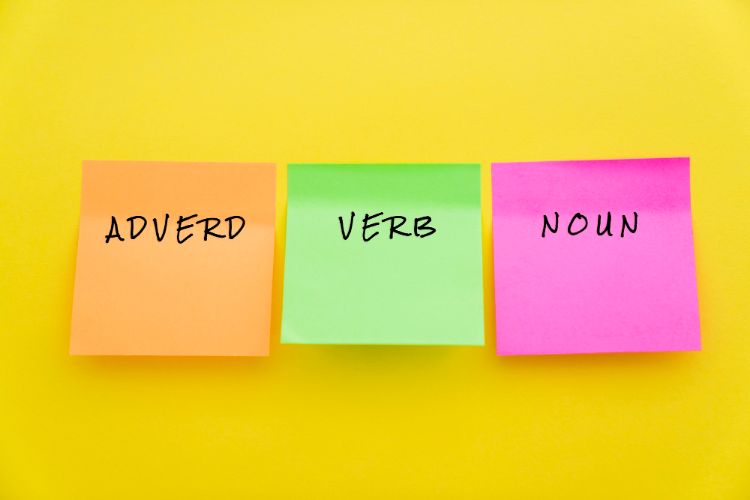Suh ChangWhoon
Written by 서 창훈, a certified Korean teacher with 14+ years of experience in Japan. He previously worked as a government officer, cybersecurity consultant, and English interpreter. Today, he teaches Korean in real classrooms without complex grammar explanations — instead, he trains students’ brains to speak naturally. His unique method is now the foundation of all his Korean courses.
Table of Contents
The basic Korean Adjectives
If you’re starting to learn Korean, you’ll quickly encounter Korean adjectives. Describing things is, after all, a fundamental part of any language! While Korean grammar can seem daunting at first, the basic structure of Korean adjectives is actually quite straightforward.
One of the most noticeable features is that *almost all* Korean adjectives, in their dictionary form, end with the syllable -다 (-da). Think of it as their “default” ending.
Let’s look at some Korean adjectives list:
예쁘다 (ye-ppeu-da): pretty, beautiful
크다 (keu-da): big, large
작다 (jak-da): small
좋다 (jo-ta): good
나쁘다 (na-ppeu-da): bad
맛있다 (ma-sit-ta): delicious
비싸다 (bi-ssa-da): expensive
See the pattern? Every single one ends in -다!
Why ‘-da’?
The ‘-da’ ending indicates the declarative form of the Korean adjectives. It’s how the Korean adjectives are listed in the dictionary and how you’ll often see it in simple statements, or when just stating a fact. It essentially signifies the Korean adjectives are that quality.
Important Note: You usually don’t use the ‘-da’ ending when you’re actively using the adjective to describe a noun or within a sentence. You’ll need to conjugate the adjective based on the level of politeness and the grammatical structure of the sentence. In these cases, the -다 will be dropped and the stem will be modified.
Types of Korean Adjectives
Korean adjectives can be classified into two primary categories: descriptive adjectives and an adjective form of verbs called stative verbs.
Descriptive adjectives directly express a quality. For example, the adjective “예쁘다” (yeppeuda) means “to be pretty,” and when used in a sentence, it modifies the noun it describes.
Story Style Breakdown™ (Example Sentence)
Let’s break down the first sentence using our Story Style Breakdown™ so you can really understand it:
Original Korean Sentence
꽃이 예쁘다.
Pronunciation Guide
꼬치 (ggo-chi) 예쁘다 (ye-bbeu-da).
Meaning and Context
꽃 (flower) 이 (I’m going to talk about the flowers) 예쁘 (to be pretty/beautiful) 다 (are; I’m expressing my opinion).
Grammar
* 이/가: Subject marker used with a noun. “이” is used after words ending in a consonant, and “가” is used after words ending in a vowel.
English Translation
The flowers are pretty.
Literal Translation
Flowers are pretty.
In contrast, stative verbs, such as “좋다” (jota), meaning “to be good,” can function similarly to Korean adjectives when used in a context that describes a state of being.
Original Korean Sentence
날씨가 좋다.
Pronunciation Guide
날씨가 (nal-ssi-ga) 조타 (jo-ta).
Meaning and Context
날씨 (weather) 가 (subject particle; used with words ending in vowels) 좋 (to be good) 다 (is; I’m expressing my opinion).
English Translation
The weather is good.
Literal Translation
Weather is good.
Korean adjectives work differently
Korean adjectives work differently from English adjectives. In English, adjectives stay the same regardless of how they are used in a sentence (e.g., “big” stays “big”). However, Korean adjectives function like verbs—they conjugate based on tense and politeness level.
Korean Adjectives Before Nouns
Korean Adjectives always end in “-다” (-da). This is their basic, or dictionary form. Think of it like the “to be” form in English, like “to be big,” “to be small,” or “to be pretty.”
However, when you want to use Korean adjectives *directly before* a noun (a person, place, or thing), you need to change them a little bit. This change is important to make the sentence grammatically correct and natural-sounding.
Let’s break it down with the examples:
크다 (keu-da): to be big
* This is the dictionary form.
* When you want to say “big house,” you change “크다” (*keu-da*) to “큰” (*keun*).
* So, big house is 큰 집 (keun jip). Notice the “-다” disappears and is replaced with “-ㄴ”. The “-ㄴ” is placed at the bottom of the preceding syllable as a final consonant (batchim).
작다 (jak-da): to be small
* This is the dictionary form.
* When you want to say “small bag,” you change “작다” (*jak-da*) to “작은” (*jageun*).
* So, small bag is 작은 가방 (jageun gabang). Similarly to the example above, the “-다” disappears and is replaced with “-은”. The “-은” is placed at the bottom of the preceding syllable as a final consonant (batchim).
예쁘다 (ye-ppeu-da): to be pretty
* This is the dictionary form.
* When you want to say “pretty flower,” you change “예쁘다” (*ye-ppeu-da*) to “예쁜” (*ye-ppeun*).
* So, pretty flower is 예쁜 꽃 (ye-ppeun kkot). Again, the “-다” disappears and is replaced with “-ㄴ”. The “-ㄴ” is placed at the bottom of the preceding syllable as a final consonant (batchim).
Why does this happen?
Essentially, it’s a grammar rule in Korean. These adjectives are being used to *modify* the noun, so they take a special form. The specific ending depends on whether the adjective stem (the part before the “-다”) ends in a vowel or a consonant.
Adjectives ending in a vowel: In the examples above, “크다” and “예쁘다” originally end in a vowel, so “-ㄴ” is attached to the original form to modify the noun.
Adjectives ending in a consonant: In the example above, “작다” originally ends in a consonant, so “-은” is attached to the original form to modify the noun.
Key takeaway: Don’t be confused by the dictionary form ending in “-다.” When an adjective comes before a noun, remember to change it by either adding “-ㄴ” or “-은”! You’ll learn which one to use with practice.
Conjugating Common Korean Adjectives
Korean adjectives work like verbs—they must be conjugated based on tense and politeness level. Let’s break down how to conjugate them in different tenses.

Present Tense (현재형)
In present tense, Korean adjectives don’t need an extra verb like “to be.” Instead, you drop -다 and add -아/어/여요 depending on the vowel in the stem.
Original Korean Sentence
가방이 작아요.
Pronunciation Guide
가방이 (ga-bang-i) 자가요 (ja-ga-yo).
Meaning and Context
가방 (bag) 이 (I’m going to talk about the bag) 작 (to be small) 아요 (is; I’m telling you polite and friendly).
Grammar
* 이/가: Subject marker used with a noun. “이” is used after words ending in a consonant, and “가” is used after words ending in a vowel.
English Translation
The bag is small.
Literal Translation
Bag is small.
Original Korean Sentence
이 집은 커요.
Pronunciation Guide
이 (i) 지븐 (ji-beun) 커요 (keo-yo).
Meaning and Context
이 (this) 집 (house) 은 (my new topic is this house) 크 (to be big) 어요 (is; I’m telling you polite and friendly).
Pronunciation Patterns for Conjugations
⊳ 크 + 어 = 커
When rapidly pronounced, ‘크’ and ‘어’ naturally combine to form ‘커’.
Grammar
* 은/는: topic marker used with a noun. ‘은’ is used after words ending in a consonant, and ‘는’ is used after words ending in a vowel.
English Translation
This house is big.
Past Tense (과거형)
To form the past tense, take the present tense stem and add -ㅆ어요/-ㅆ아요, or 었어요/았어요.
Original Korean Sentence
가방이 작았어요.
Pronunciation Guide
가방이 (ga-bang-i) 자갓써요 (ja-gat-sseo-yo).
Meaning and Context
가방 (bag) 이 (subject marker) 작 (to be small) 았 (past tense) 어요 (is; I’m telling you polite and friendly).
English Translation
The bag was small.
Literal Translation
Bag was small.
Original Korean Sentence
그 집이 컸어요.
Pronunciation Guide
그 (geu) 지비 (ji-bi) 컷써요 (keot-sseo-yo).
Meaning and Context
그 (that) 집 (house) 이 (subject marker) 크 (to be big) 었 (past tense) 어요 (is; I’m telling you polite and friendly).
Pronunciation Patterns for Conjugations
⊳ 크 + 었 = 컸
When rapidly pronounced, ‘크’ and ‘었’ naturally combine to form ‘컸’.
English Translation
That house was big.
Future Tense (미래형)
To form the future tense, take the stem and add -ㄹ/을 거예요. If the stem ends in a vowel, add -ㄹ 거예요. If the stem ends in a consonant, add -을 거예요.
Original Korean Sentence
가방이 작을 거예요.
Pronunciation Guide
가방이 (ga-bang-i) 자글 (ja-geul) 꺼예요 (ggeo-ye-yo).
Meaning and Context
가방 (bag) 이 (subject marker) 작 (to be small) 을 거예요 (will; I’m telling you polite and friendly).
English Translation
The bag will be small.
Literal Translation
Bag will be small.
Original Korean Sentence
이 집은 클 거예요.
Pronunciation Guide
이 (i) 지븐 (ji-beun) 클 (keul) 꺼예요 (ggeo-ye-yo).
Meaning and Context
이 (this) 집 (house) 은 (topic marker) 크 (to be big) ㄹ 거예요 (will; I’m telling you polite and friendly).
Pronunciation Patterns for Conjugations
⊳ 크 + ㄹ = 클
When rapidly pronounced, ‘크’ and ‘ㄹ’ naturally combine to form ‘클’.
English Translation
This house will be big.
From My Original Story Style Breakdown™ — A New Way to Truly Understand Korean
This is just one sentence from a complete learning system you won’t find anywhere else. — designed to help you understand Korean naturally, without getting lost in grammar rules.
When you can truly understand Korean sentences this way, speaking becomes much easier.
🟡 Sentence 1 of 7

Original Korean Sentence
사자가 코끼리를 잡아요.
Pronunciation Guide
사자가 (sa-ja-ga) 코끼리를 (ko-ggi-ri-reul) 자바요 (ja-ba-yo).
Meaning and Context
사자 (lion)
→ The lion — the one taking action now in the story.
가 (subject marker)
→ Points out that the lion is doing the action.
코끼리 (elephant)
→ The one the action is done to.
를 (object marker)
→ Shows that the elephant is the object being caught.
잡 (to catch, grab, take)
→ The action — the lion catches or grabs the elephant.
아요 (polite ending)
→ I’m telling you this in a polite and friendly way.
Real-Life Usage
잡아요 is common when talking about catching or holding something.
English Translation
The lion catches the elephant.
Literal Translation
Lion catch elephant.
Pattern Practice
사자가 토끼를 잡아요.
고양이가 쥐를 잡아요.
아이가 공을 잡아요.
강아지가 장난감을 잡아요.
In my full Story Course, each sentence comes with even more — depending on the sentence, you’ll also find grammar tips, pronunciation flow advice, and culture insights to help you truly understand and use Korean.
Start the Free Course
Still wondering how to read Korean?

This isn’t just another beginner lesson. It’s a complete system designed to change the way you think about Korean — from struggling with letters to reading real sentences, understanding the language, and speaking out loud with confidence.
Start the Story Course
Looking for super easy way to learn Korean?
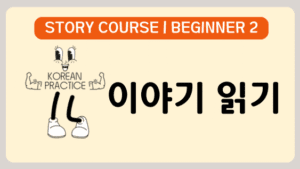
Most Korean courses stop at grammar. Mine goes beyond — with stories, Story Style Breakdown™, and real practice to help you speak.
Free Korean Flashcard
FAQs (What You Might Still Wonder About)
1. ❓ What are the most common Korean adjectives beginners should learn first?
If you’re just starting out, focus on common Korean adjectives like 예쁘다 (pretty), 크다 (big), 작다 (small), and 맛있다 (delicious). These words appear constantly in daily conversation and help you describe almost anything.
2. ❓ How many basic Korean adjectives do I need to know to sound natural?
You don’t need hundreds! Even 20–30 basic Korean adjectives will help you sound much more natural. They’re super versatile and easy to conjugate once you understand the pattern.
3. ❓ Is there a simple Korean adjectives list I can memorize quickly?
Yes! A short Korean adjectives list like 좋다 (good), 나쁘다 (bad), 비싸다 (expensive), 싸다 (cheap), and 재미있다 (fun) is a great starting point. Once you master these, you can expand your vocabulary step by step.
4. ❓ Why do Korean adjectives act like verbs instead of staying the same like in English?
In Korean, adjectives are more like “descriptive verbs.” That’s why they conjugate for tense and politeness. This might feel strange at first, but it actually makes Korean adjectives vocabulary easier to learn because the rules are consistent.
5. ❓ How do I use Korean adjectives before nouns correctly?
You need to slightly change their form. For example, 크다 (to be big) becomes 큰 when placed before a noun, like 큰 집 (big house). This happens with almost all common Korean adjectives.
6. ❓ What’s the fastest way to learn and remember basic Korean adjectives?
Use them in simple sentences every day. For example, point to something and say “이 가방은 작아요” (This bag is small). Repetition with real-life examples helps the adjectives stick in your memory.
7. ❓ Are there different politeness levels for Korean adjectives?
Yes! Just like verbs, Korean adjectives change based on politeness. For example, 좋다 (good) becomes 좋아요 in polite speech, and 좋습니다 in formal situations. Learning this will make your Korean adjectives vocabulary more flexible.
Final words: Mastering Korean Adjectives
orean adjectives are essential for expressing descriptions, emotions, and opinions. Unlike English, they function like verbs and must be conjugated based on tense and usage. By understanding how to modify nouns, form different tenses, and use key patterns, you can describe Korean adjectives vocabulary naturally in Korean.



With practice, Korean adjectives will become second nature. Want to learn them in a simple, structured way? My courses break down grammar step by step, helping you master Korean easily. Try free sample lessons today!
